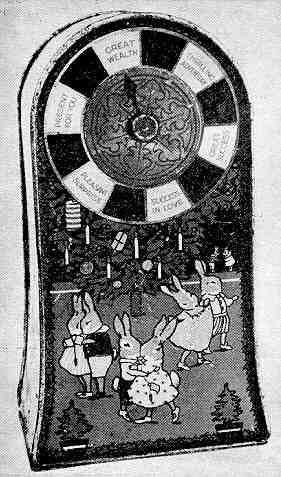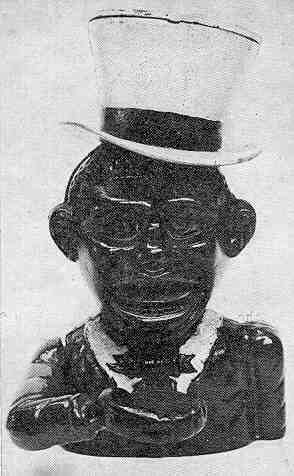Lucky Wheel Money Box
Little Hi-Hat
by F.H. Griffith - HOBBIES Magazine - November, 1968
 Two English banks, one appropriate for the Christmas Season and
made of tin, and the other cast iron, both quite difficult to come by, are the subjects
for our dual classification article for November.
Two English banks, one appropriate for the Christmas Season and
made of tin, and the other cast iron, both quite difficult to come by, are the subjects
for our dual classification article for November.
The first of these, No. 164 in the classification, Figure 1, is the Lucky Wheel Money Box, a quite rare tin bank. Leonard A. Galati of California, to the best of the writer’s knowledge, is the initial collector to discover an example of this bank. The bank came to him through an English source and it is in very nice condition.
W. & R. Jacob & Company of England were the distributors of the Lucky Wheel Bank. Jacob & Company are a well known, very fine, long established concern who produce various delicacies in biscuits and cakes. The Lucky Wheel was originally filled with small iced biscuits and sold only during the Christmas Season of 1929. In the 1920’s and 30’s they introduced a special children’s novelty tin each Christmas, but 1929 was the only time they featured a mechanical money box.
The bank shown in Figure 1, as previously mentioned, is in fine original condition. Colors are as follows: The large circle on the front with the sections where the fortunes appear are in alternate colors of dark blue and yellow. Red lettering appears on the yellow and black lettering on the blue. The gold decorated center wheel has a black arrow thereon. Below this on a predominantly red and blue background are four pairs of tan rabbits attending a dance. They are dressed in bright colors of blue, red, white, lavender and yellow. The lower part of a Christmas tree with red berries, candles, and vari-colored Christmas balls appear just under the wheel. Green holly with red berries is around the entire front edge and two small Christmas trees in blue pots are in the bottom foreground. Ornamentation of similar nature to that just described is along the sides and curved top of the bank. This all adds up to a very bright, gayly colored Christmas-y bank.
The operation of the bank depends upon the insertion of a coin and this is always a desirable feature in a mechanical bank. When the coin is deposited in the provided slot in the top of the bank the weight of the coin causes the wheel to spin and the arrow to point to one of the 12 fortunes.
In closing on the Lucky Wheel Bank, it is very nice to have another Christmas mechanical bank turn up. It makes an appropriate subject matter companion to the Santa Claus Bank (HOBBIES, December, 1966).
* * *
 Little Hi-Hat, No. 165 in the classification, Figure 2, would seem
to be, from all evidence, a very difficult mechanical bank to add to a collection. It has
been quite a few years since the writer last heard of an example of this perky bust type
bank turning up.
Little Hi-Hat, No. 165 in the classification, Figure 2, would seem
to be, from all evidence, a very difficult mechanical bank to add to a collection. It has
been quite a few years since the writer last heard of an example of this perky bust type
bank turning up.
In appearance, except for the elegant top hat, the bank is practically identical to Little Joe, made by John Harper & Company, Ltd. of England. The writer has some of their old catalogs, 1890 to 1930, showing Little Joe, Dinah, and other bust type banks. Chamberlin & Hill, Ltd., another English concern, also made bust type banks, but no catalog of theirs or Harpers, that are in the writer’s possession, show Little Hi-Hat. The writer feels that with the very definite similarities in the castings of Little Joe and Little Hi-Hat, Harper made the bank.
The bank shown is in fine original condition with colorings similar to most of the bust type banks. The hat is white with black band, face and hand are black. Red lips and tongue with black and brown eyes. The shirt is red with white collar, and black tie. In an indented section in the back appears the name "Little Hi-Hat" in large raised gold letters.
The bank operates like the majority of the bust type banks. A coin is placed on the extended right hand as shown in the photo. A lever, left rear shoulder is depressed and the hand rises to the mouth depositing the coin therein. Tongue recedes and the eyes move upward. Releasing the lever automatically returns all parts to the positions as shown in the photo.
The exact reason for the apparent scarcity of this bank is not known to the writer, but possibly, like the English Clown Bank (Bust), (HOBBIES, May, 1961), there were not too many of them made nor were they produced over a number of years.
A final word about the name Little Hi-Hat. It would logically seem to connect this bank to Little Joe since both utilized the name "Little." This then would, of course, lead to Harper making both banks. In this case though the name cannot necessarily be a factor of this nature since the most mechanical of all the bust banks is Little Moe (HOBBIES, August, 1958), and we know this was made by Chamberlin & Hill and shown only in their old catalogs.
